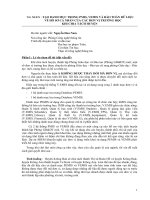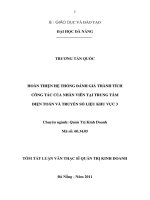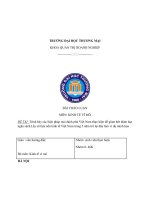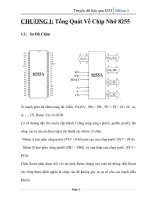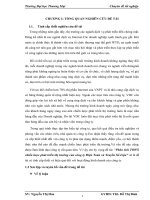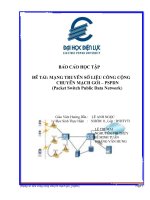Ch26 TRUYỀN SỐ LIỆU VÀ MẠNG
Bạn đang xem bản rút gọn của tài liệu. Xem và tải ngay bản đầy đủ của tài liệu tại đây (2.05 MB, 55 trang )
Chapter 26
Remote Logging,
Electronic Mail,
and File Transfer
26.1
Copyright © The McGraw-Hill Companies, Inc. Permission required for reproduction or display.
26-1 REMOTE LOGGING
It would be impossible to write a specific client/server
program for each demand. The better solution is a
general-purpose client/server program that lets a user
access any application program on a remote computer.
Topics discussed in this section:
TELNET
26.2
Note
TELNET is a general-purpose
client/server application program.
26.3
Figure 26.1 Local and remote log-in
26.4
Figure 26.2 Concept of NVT
26.5
Table 26.1 Some NVT control characters
26.6
Figure 26.3 An example of embedding
26.7
Table 26.2 Options
26.8
Table 26.3 NVT character set for option negotiation
26.9
Example 26.1
Figure 26.4 shows an example of option negotiation. In
this example, the client wants the server to echo each
character sent to the server. The echo option is enabled by
the server because it is the server that sends the
characters back to the user terminal. Therefore, the client
should request from the server the enabling of the option
using DO. The request consists of three characters: IAC,
DO, and ECHO. The server accepts the request and
enables the option. It informs the client by sending the
three-character approval: IAC, WILL, and ECHO.
26.10
Figure 26.4 Example 26.1: Echo option
26.11
Table 26.4 Character set for suboptions
26.12
Example 26.2
Figure 26.5 shows an example of suboption negotiation.
In this example, the client wants to negotiate the type
of the terminal.
26.13
Figure 26.5 Example of suboption negotiation
26.14
26-2 ELECTRONIC MAIL
One of the most popular Internet services is electronic
mail (e-mail). The designers of the Internet probably
never imagined the popularity of this application
program. Its architecture consists of several
components that we discuss in this chapter.
Topics discussed in this section:
Architecture
User Agent
Message Transfer Agent: SMTP
Message Access Agent: POP and IMAP
Web-Based Mail
26.15
Figure 26.6 First scenario in electronic mail
26.16
Note
When the sender and the receiver of an
e-mail are on the same system,
we need only two user agents.
26.17
Figure 26.7 Second scenario in electronic mail
26.18
Note
When the sender and the receiver of an
e-mail are on different systems, we
need two UAs and a pair of
MTAs (client and server).
26.19
Figure 26.8 Third scenario in electronic mail
26.20
